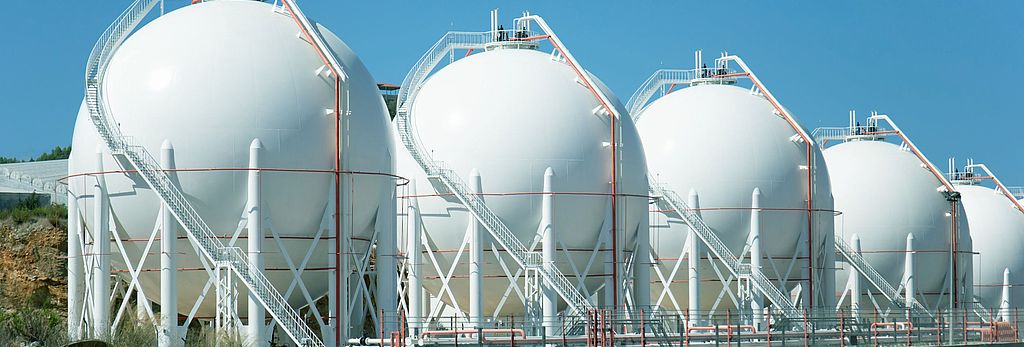
Gases
What are gases?
“Gases” is the collective term for substances that are in a gaseous state, i.e. a state of matter in which the molecules can move freely in space at a great distance from each other and uniformly fill the available space (statistical distribution of the gas particles). Compared with solids or liquids, gases occupy 1,000 to 2,000 times more space at the same mass under normal conditions
Types of gas
The best-known types of gas in the energy sector are:
- Natural gas
- Liquefied petroleum gas (LPG)
- Liquefied natural gas (LNG)
- Compressed natural gas (CNG)
Biogas (bio-methane, bio-CNG
Gases are put to a variety of uses – for refuelling vehicles and vessels, generating electricity and heat, cooking, etc. Alongside hydrocarbons, nitrogen and carbon dioxide, depending on the type of gas, gases can contain methane, ethane, ethene, propane, propene (propylene), butane, butene (butylene), isobutane (methyl propane) and isobutene (methylpropene).
What is called dry gas consists almost entirely of methane. This is the gas people are usually referring to when they talk about natural gas for heating and electrical power generation. Unlike dry gas, wet gas contains heavier compounds in addition to methane – such as ethane (or C2), propane (C3) and butane (C4). Wet gas mixtures may be gaseous or may contain liquids. These natural gas liquids (NGLs) can be broken down and their individual components sold separately. Ethane, for example, can be cracked into ethylene, which is used as a basis for many plastics. Propanes and butanes can be marketed as liquefied petroleum gas (LPG), used for heating, lighting, cooking etc.
Gaseous state of aggregation
The gaseous state of aggregation is arrived at from solid or liquid form by the addition of energy (heat). For some elements and compounds, the standard temperature of 20⁰C and a pressure of 1 bar is enough to become gaseous. Ultimately, however, all matter will become gaseous at a sufficiently high temperature. The following transitional physical states of aggregation are possible:
- Liquid to gaseous: Called “vaporization” above boiling point and “evaporation” below boiling point
- Gaseous to liquid (condensation)
- Direct transition from solid to gaseous state (sublimation)
- Gaseous to solid (resublimation)
Traits
Gases, like liquids, are classified as fluids: they flow and do not resist deformation, even though they have viscosity.
Gases also have specific traits such as combustible, oxidizing, toxic, self-igniting or corrosive. Some gases even exhibit several of these properties: Flammable gases have an ignition range with air or other oxidizing substances. Self-igniting gases have an ignition temperature below 100⁰C; they can ignite at room temperature when mixed with air or other oxidizing substances. Oxidizing gases promote combustion, but are not flammable themselves. Corrosive gases attack many materials, especially metals, and have a corrosive effect on skin and mucous membranes. Toxic gases may be extremely harmful or even fatal to humans and animals if inhaled or absorbed through the skin; some gases are also considered as carcinogenic or teratogenic and can cause long-term damage to humans and the environment. Environmentally hazardous gases can also affect the ozone layer and contribute to global warming.
Health, safety, security & environment (HSSE) is also a top priority when working with gases, gas containers and tanks, i.e. in their transport, storage, handling, emptying and use. Special advisories for individual gases are provided in their respective safety data sheets / material data sheets. Furthermore, there are local government and industry regulations to be observed, such as the Occupational Exposure Limit (OEL, “Arbeitsplatzgrenzwert AGW”) and the Regulation on the transportation of dangerous goods on roads and by railroad (“Gefahrgutverordnung Straße und Eisenbahn”, GGVSE) in Germany.
Storage of gases
Gases must be stored with especial care, because beyond their specific traits, the pressure of gases must be taken into account. The pressure range is divided into low pressure (gas pressure up to 0.1 bar), medium pressure (gas pressure up to 1 bar) and high pressure (gas pressure above 1 bar). In order to store the greatest possible amount of gas in a container, i.e. to achieve a high density, gas can be highly compressed. There are various storage techniques to choose from:
- For storing very large amounts of gas, high-pressure accumulators (pressure of approx. 100 bar) may be used, such as underground pipes, and caverns deep in the ground.
- Spherical gas tanks are used for storing products at high pressure (overpressure). Depending on the diameter of the steel sphere and the thickness of its walls, storage at up to 20 bars of gas pressure is possible. They are suitable for medium volumes such as in industry.
- Gases liquefied through cooling and compression either remain cold and liquid at atmospheric pressure due to evaporation enthalpy – with appropriate heat insulation (as in oxygen and nitrogen tanks), or are placed under pressure to remain liquid (for example, propane/butane in cigarette lighters or camping gas bottles).
- Variable volume, gas-tight containers are used at low pressure, such as disc-type and floating-bell gas containers.
- Smaller amounts of gasare transported and stored in cylindrical compressed-gas cylinders or pressurized gas cans/bombs. These containers are usually made of steel, have a hemispherical bottom, a filling volume from 1 to 100 l and a filling pressure of up to 200 bar. They are color-coded and engraved with information such as the type of gas, filling pressure or capacity, volume or empty weight, serial number, and test pressure.
Mabanaft is active in trading, supply and project development for NGLs and their derivatives from our offices in London and Singapore via our business unit New Energy, Chemicals & Gas. Our Marketing business unit including the Petronord group are also active in trading gas.
Mabanaft business unit New Energy, Chemicals & Gas
Gases at Petronord
Status: December 2015
All information subject to change. Errors and omissions excepted.

